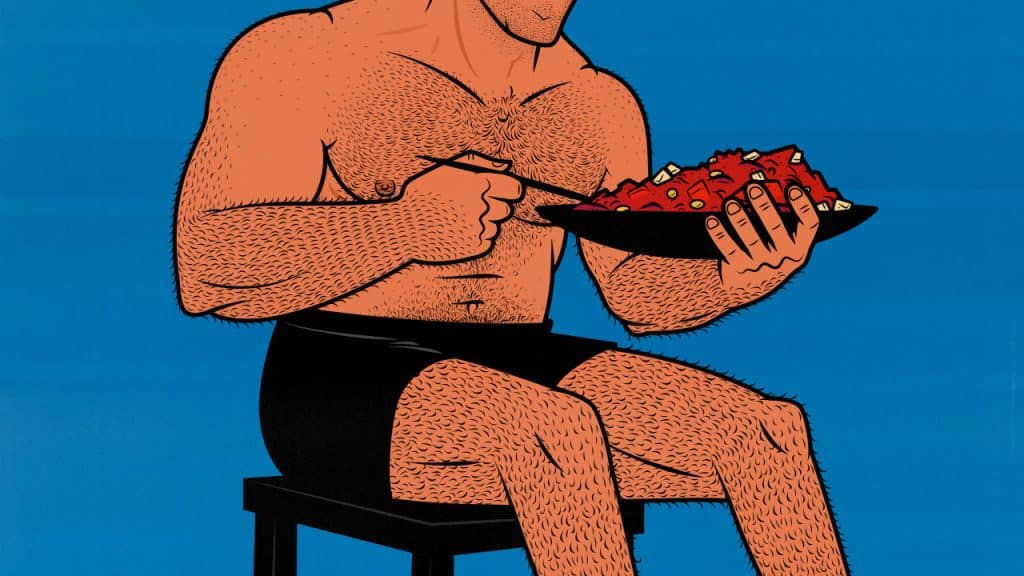
The Best High-Calorie Bulking Meals (With Recipes)
One of our most popular articles is about how to eat a good bulking diet. It covers all the most important principles—how to choose nutritious foods, what macros to aim for, how to calculate your calorie needs, how to adjust those calories based on your results (or lack thereof), and so much more.
However, it doesn’t give many examples of good bulking meals, and it doesn’t have any recipes. That’s where this article comes in. These are some of my favourite bulking meals. I’ve used them to gain 70 pounds, and we’ve been using them with clients for over a decade now. I’ll give you recipes for all of them, with the calories and macros calculated out.
Feel free to ask questions. I’ll answer all the comments.
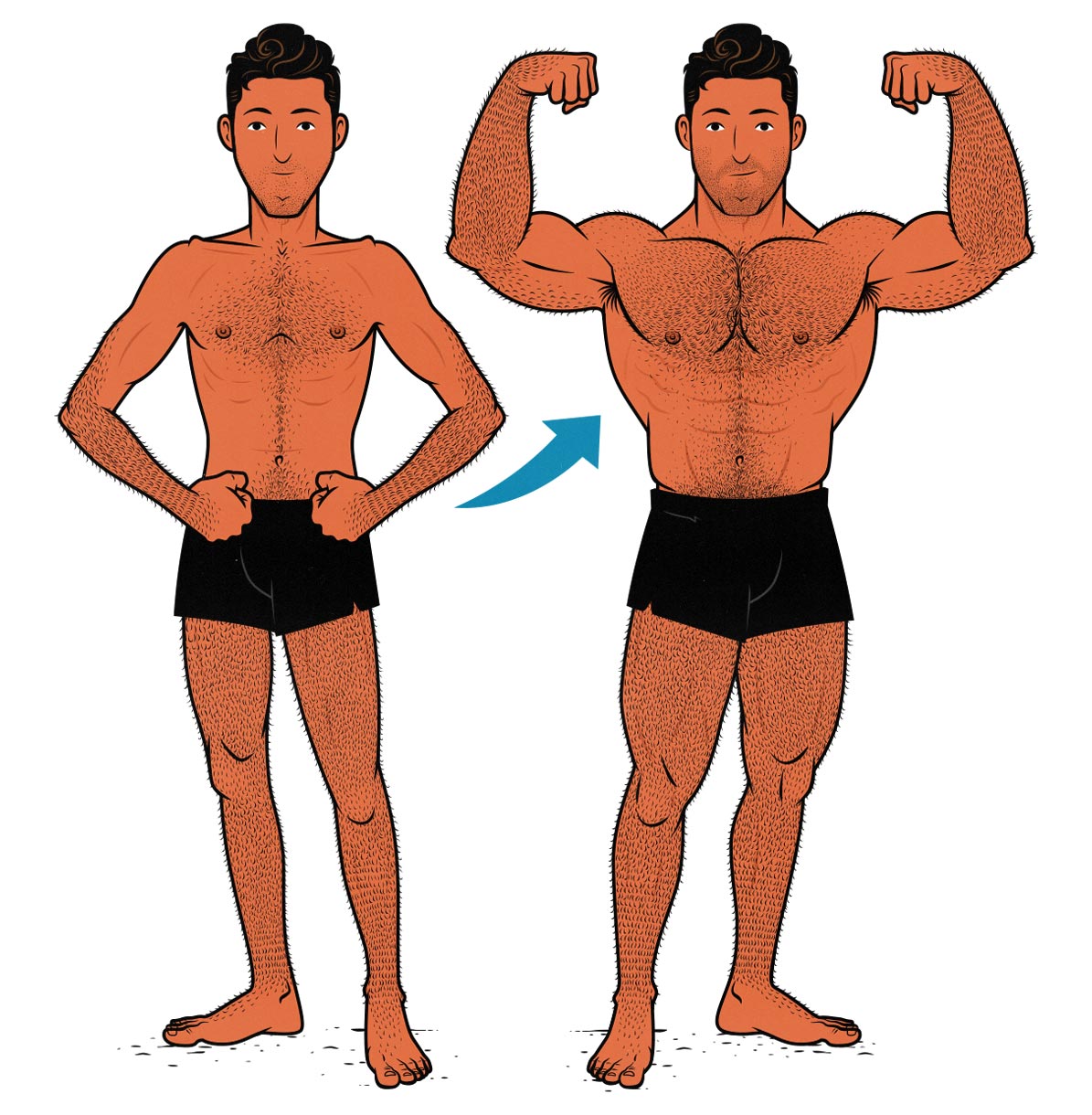
What Makes a Good Bulking Meal?
Bulking meals need to have enough calories and protein, giving you the energy and amino acids you need to build muscle. That means we’re looking for high-calorie meals with at least 30–40 grams of protein—often more. Snacks can have less, but that’s a topic for another article.
These meals should also be easy on your appetite. It’s hard to eat enough calories to gain weight, especially if you’re like me, with the metabolism and stomach size of a hummingbird. So, it helps to have calorically dense meals that fit easily into smaller stomachs, digest quickly, and leave you feeling hungry again soon.
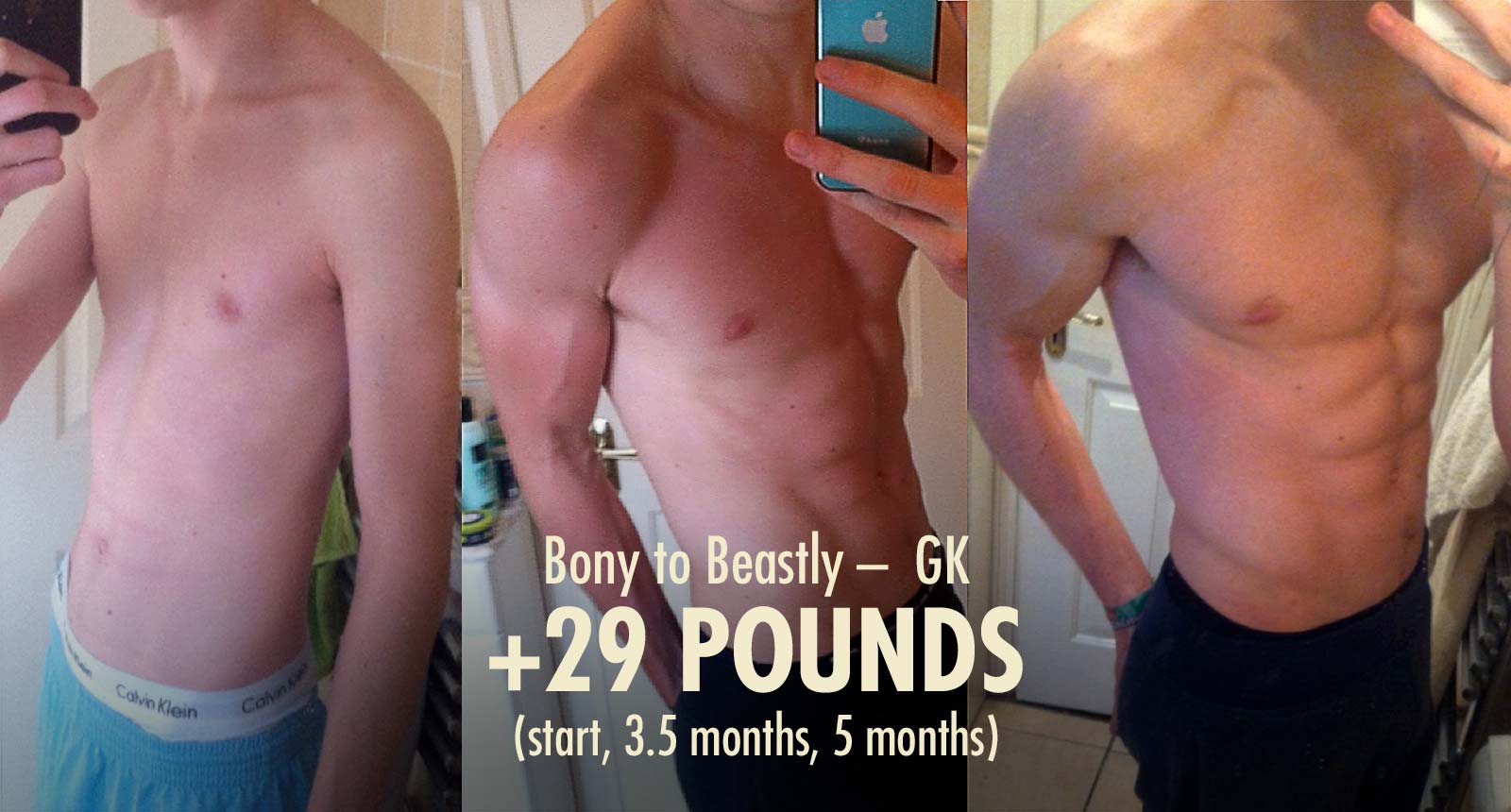
The meals should have a balanced mix of carbs and fat, ideally leaning more towards starchy carbs. Both carbs and fats are rich in energy, vitamins, and minerals, but they each boast different benefits:
- Starchy carbs pump your muscles full of glycogen, making them fuller, improving your workout performance, and speeding up your rate of muscle growth (full explanation). Ideally, these carbs would be minimally processed (e.g. oatmeal instead of flour, corn instead of corn syrup).
- Fats contain fat-soluble micronutrients, and they help manage our hormones. Most of the fat we eat should be monounsaturated and polyunsaturated, but some saturated fat from dairy and dark chocolate is fine, especially if you’re having it with balanced meals that are rich in fibre.
We also want to foster a healthy gut microbiome, improving digestive power and health. Probiotics from fermented foods can help with that, but the strongest evidence is for prebiotics—fibre. Ideally, you’d have at least ten grams of fibre per thousand calories. Even better if that fibre comes from several different sources.
Finally, a nutritious bulking diet is rich in a balanced mix of micronutrients. A good bulking meal is made from minimally processed foods that are rich in vitamins, minerals, antioxidants, nitrates, and other phytonutrients. This means getting calories from a mix of fruits, vegetables, nuts, seeds, legumes, dairy, meat, seafood, spices, coffee, tea, and so on.
With all that in mind, let’s combine those principles into a few different bulking meals.
The Bulking Recipes
Generic Bulking Smoothie (Snack/Breakfast)
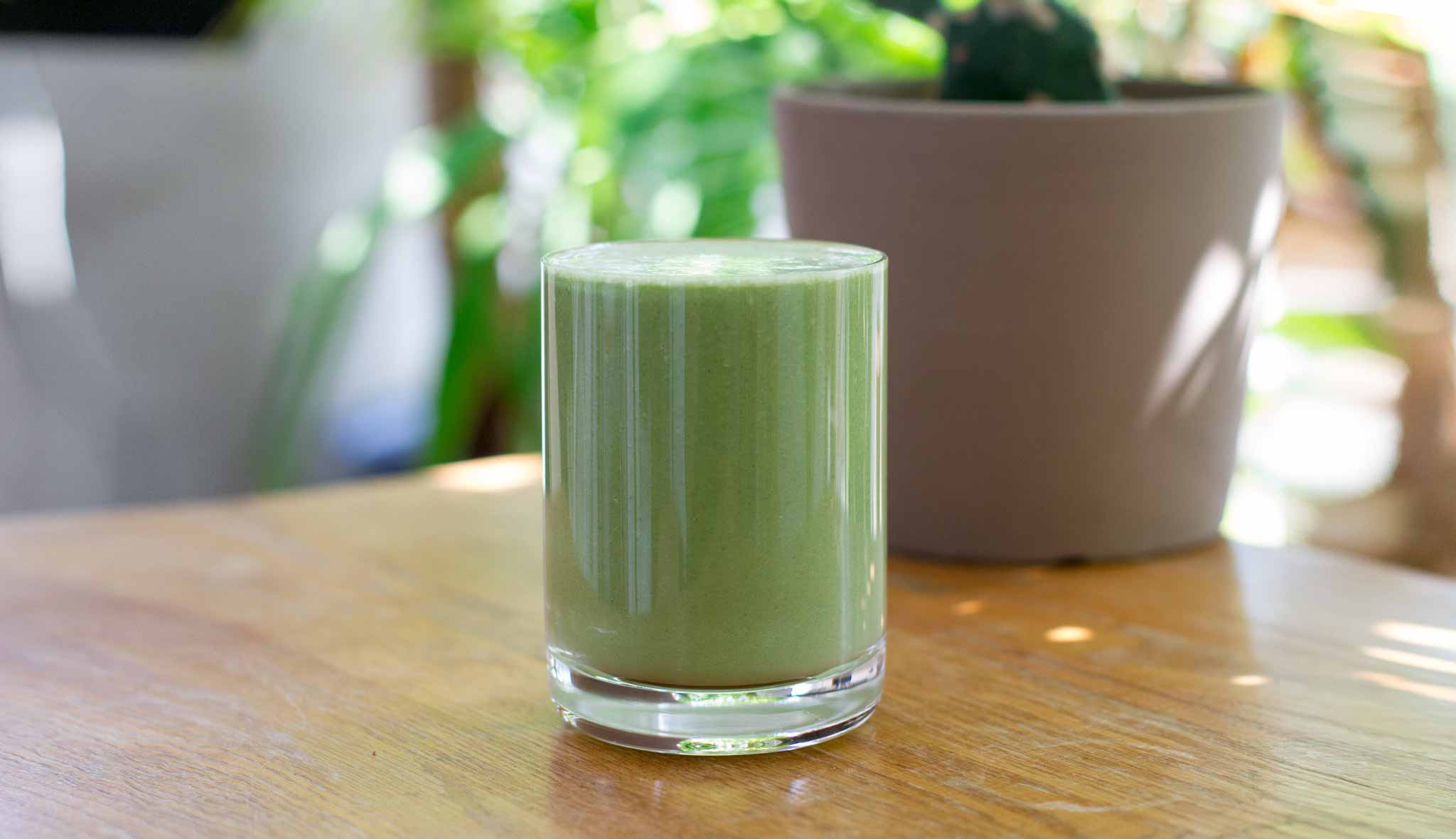
Smoothies are the ultimate bulking meal (or snack). They’re simple to make, easy to drink, and they pass through your digestive system quickly. You can pack them full of healthy foods, using them almost like high-calorie multivitamins. Blended foods are just as nutritious as whole ones.
If you don’t eat very many leafy green vegetables, add a handful of spinach. Or if your diet is low on protein, add some extra Greek yogurt or protein powder. If you need more fibre, add more oats, chia, or fruit. For more carbs, add another banana or some extra oats.
This recipe is as basic as it gets. It’s a classic bulking smoothie. That should serve as a good default to build upon. If you’re looking for more exotic recipes, we have an article on high-calorie bulking smoothies. I also have an article with more bulking breakfast recipes.
Calories & Macros
- Calories: 500 kcal
- Protein: 40 grams
- Carbs: 55 grams
- Fat: 20 grams
- Fibre: 20 grams
Ingredients
- 1 banana (frozen or fresh)
- 1 handful fresh spinach
- 1 tablespoon of almond butter
- 4 frozen strawberries
- 1 tablespoon flax or chia seeds
- 225ml of cold milk, soy milk, or oat milk
- 1 scoop of unflavoured protein powder
Instructions
- Blend all the ingredients except for the protein powder.
- Add the protein powder and blend it gently until it’s mixed in.
High-Protein Oatmeal (Second Breakfast)
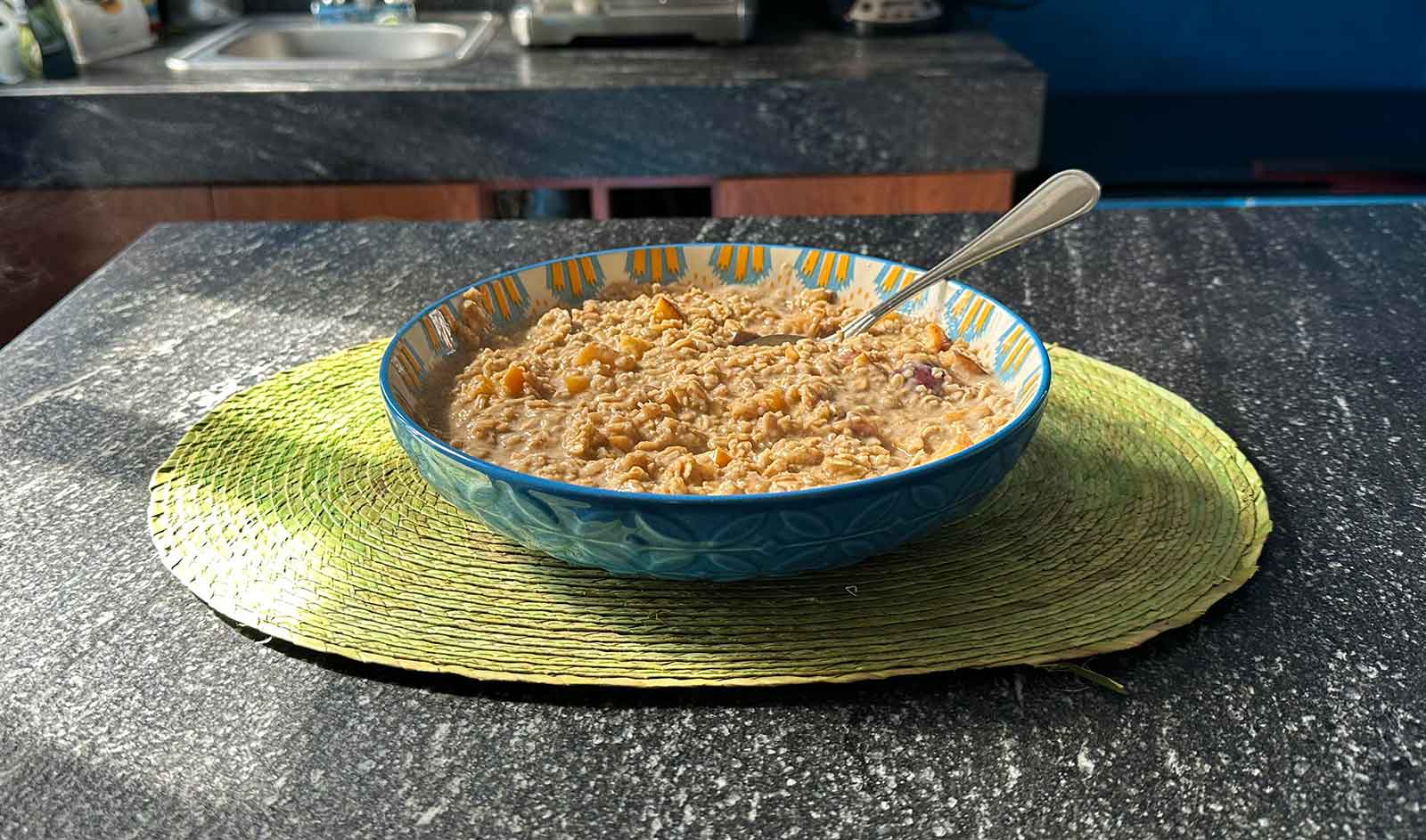
Oatmeal is the most popular breakfast among bodybuilders. That’s because it’s rich in starchy carbs, high in fibre, easy to make, and you can pack it full of protein and calories. The calories are also “clean,” as the bodybuilders say—the ingredients are minimally processed and rich in nutrients.
The first problem with oatmeal is that it can be surprisingly filling. To overcome that, we need to mix in some high-calorie ingredients that don’t increase the volume of the meal by very much. We do this by using milk instead of water, then mixing in honey and protein powder. This makes the meal calorically denser, making it easier to get into a calorie surplus.
The second problem is that oatmeal can be somewhat boring. It’s easy for it to feel like eating spoonful after spoonful of sludge. You can fix that by mixing in fruit that has a nice texture and tartness to it. I usually dice up a peach, mango, or apple, but you can use whatever fruit you like. And, of course, these fruits add more calories, carbs, fibre, and phytonutrients.
Calories & Macros
- Calories: 850 kcal
- Protein: 55 grams
- Carbs: 115 grams
- Fat: 22 grams
- Fiber: 10 grams
Ingredients
- 1 cup oats (such as quick oats)
- 2 cups whole milk (or soy milk, low-fat milk, etc)
- 1 diced peach (or apple, mangoes, berries, etc)
- 1 tbsp honey
- 1 scoop protein powder (e.g. whey isolate)*
- A pinch of salt
- 1 tsp cinnamon
- ¼ tsp vanilla
- 1 tsp ashwagandha powder (optional)**
*You can use any kind of unflavoured protein powder. Whey makes for a good default. If you’d rather buy flavoured protein, both vanilla and cookies-and-cream suit the recipe well. We have specific brand recommendations here.
**Ashwagandha powder tastes like a cousin of cinnamon. The flavour goes well with oatmeal. It’s a nutritious food that seems to be especially good for easing stress and improving recovery. It’s totally optional.
Instructions
- Bring 2 cups of milk to a boil, then reduce the heat to low.
- Stir in the oatmeal and diced peach. I don’t mind if you stir them in before the milk comes to a boil. Keep stirring occasionally. If you don’t, some of your calories might stick to the bottom of the pot.
- As the oatmeal cooks, stir in the honey, protein powder, cinnamon, and salt. You could also add vanilla and maybe even some ashwagandha.
- If you’re using quick oats, let them cook for around 5 minutes. Old-fashioned oats will take a couple of minutes longer. You can eat oats as raw as you like, but they’re easier to digest when cooked.
- The oatmeal should come out slightly watery. That’s good. It will be easier to eat and digest that way. Overly dry oatmeal can be tough to get through.
Peanut Butter and Banana Sandwich (Lunch)
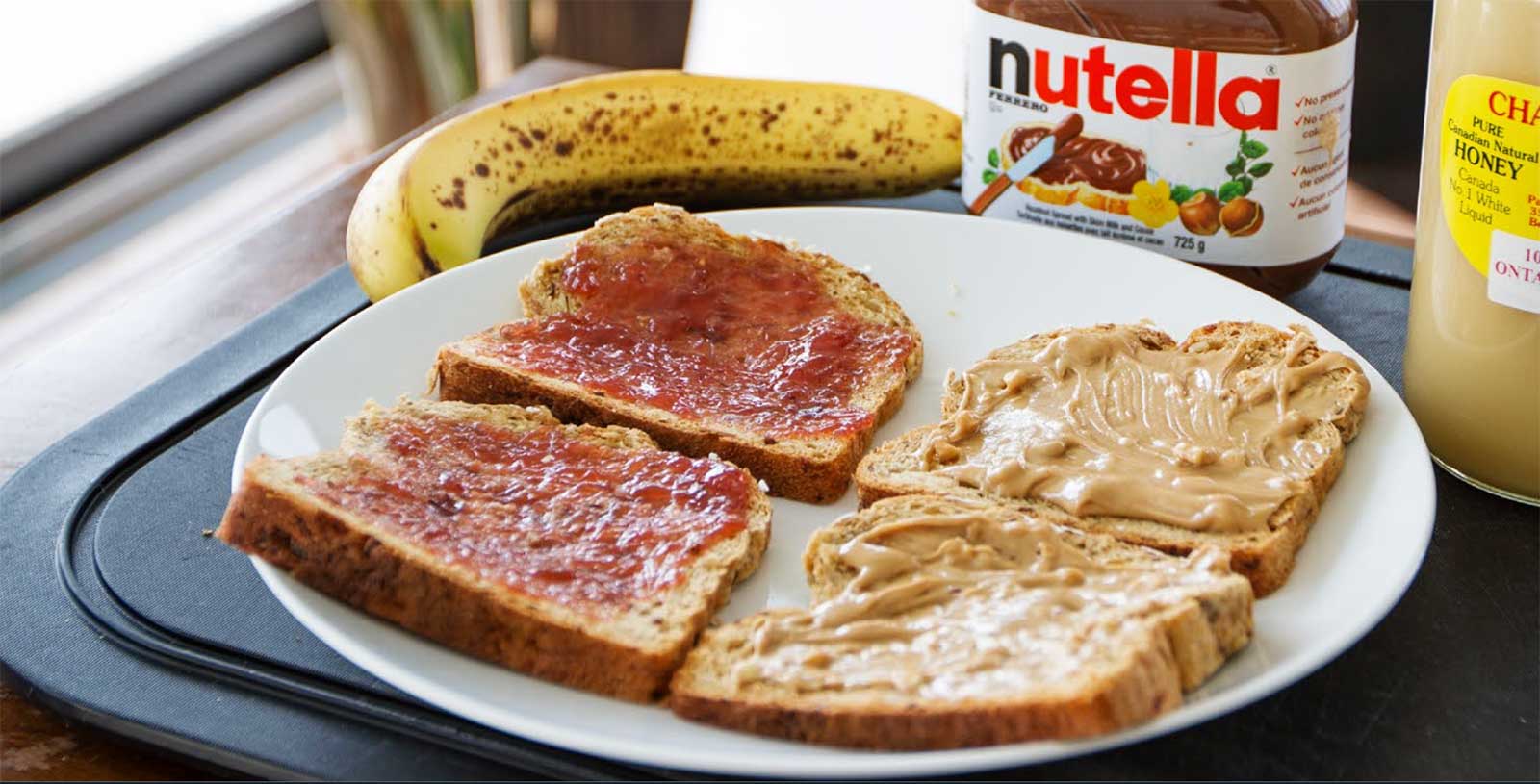
You can go as fancy as you want with your meals. Any balanced meal can be part of a healthy bulking diet. What I want to do with this article is teach you how simple and easy it can be. That’s why we’re using a peanut butter and banana sandwich.
There’s another principle to teach here, too. Plant-based foods usually have less protein per calorie, and their amino acid profiles aren’t as balanced. That can make it seem like they wouldn’t be as good for bulking, but that isn’t so. You just need to mix them together. In this case, we’re mixing whole-grain bread (carbs and protein) with peanut butter (fat and protein) to get a balanced vegan bulking meal.
If a sandwich is too much effort, you could get premade trail mix instead. It’s a similar idea. By mixing nuts and seeds with fruits, you get a balanced, high-calorie plant-based bulking meal that’s surprisingly rich in protein.
Calories & Macros
- Calories: 930 kcal
- Protein: 35 grams
- Carbs: 150 grams
- Fat: 33 grams
- Fiber: 24 grams
Ingredients
- 4 slices of whole-grain bread*
- 4 tbsp peanut butter
- 2 bananas (or jam)**
*If you’d rather eat fewer meals more often, feel free to make just one sandwich.
**Bananas are whole foods that are rich in prebiotics, making them great for bulking. But jam is often easier, and it keeps for longer. Either one is fine.
Instructions
- Lightly toast the bread.
- Spread peanut butter on two of the slices. 2 tablespoons per slice. That’s more peanut butter than you might be used to. Remember, this is a bulking meal.
- Slice up each banana into around 9 slices, artfully arranging them on the layer of peanut butter. Feel free to use jam instead.
- Close the sandwich.
Sunday Night Chili (Dinner)
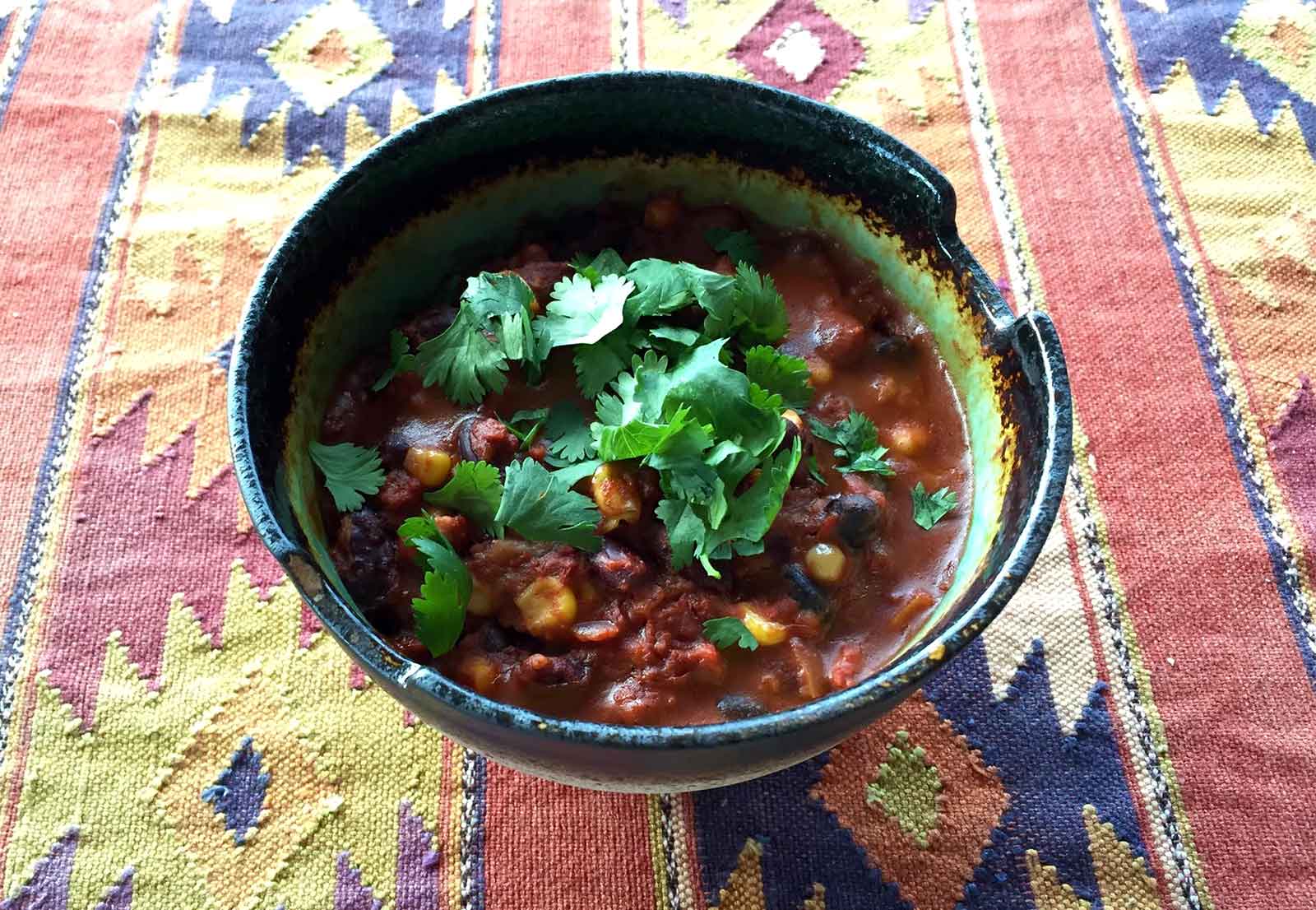
In the natural bodybuilding world, there’s a tradition of spending every Sunday afternoon prepping your meals for the week. They call it meal prep. I’m not a bodybuilder, but there’s definitely value in cooking at least some of your meals in bulk. Chili is perfect for that.
If you’re vegan, you can swap the meat with lentils or make lentil stew instead.
If you cook up a big pot of chili or lentil stew every Sunday night, you can have enough leftovers for the entire week. Chili keeps for at least a week in the fridge. You can save some of the servings in the freezer for months. Whenever you’re feeling lazy, all you need to do is nuke some leftovers in the microwave, and you’ll have a perfectly nutritious bulking meal ready in minutes.
Ground meat is easy to cook, pleasant to eat, and easy to digest. I’m not the first one to notice this. The Vertical Diet has Monster Mash. Tim Ferriss had a strange chilli-and-macaroni meal. Most people who optimise their bulking diets wind up with some sort of chili-like meal. We can make that meal even better by combining ground meat with fibrous carbs. In this case, beans, corn, garlic, onions, tomato sauce, chili peppers, and other spices, yielding a perfectly balanced mix of micronutrients.
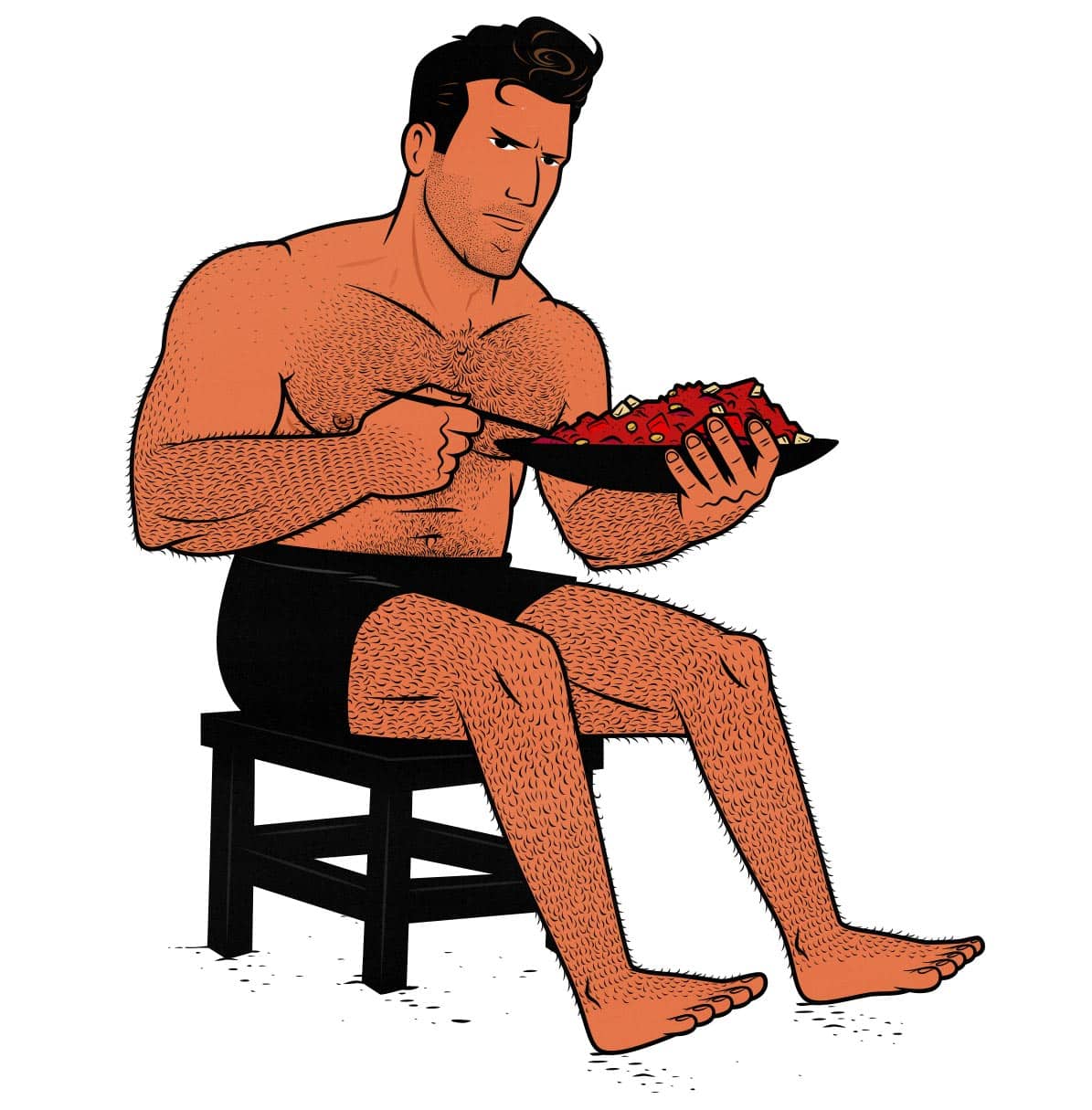
However, most people make chili with red meat, and red meat is somewhat controversial. There’s no doubt it’s great for building muscle. It’s nutritious, too, in the sense that it’s packed full of amino acids, vitamins, and minerals. However, the research on its other health effects is murky. Higher consumption of red meat is sometimes associated with worse health outcomes (systematic review).
It’s tricky because an association doesn’t tell us very much about what’s causing the problem. Perhaps the problem is the nitrites in processed meat, which isn’t an issue here. Maybe it’s simply the saturated fat, in which case extra-lean ground beef would be fine. Perhaps the problem is when meat gets charred, which wouldn’t happen when cooking chili. In moderation, you wouldn’t need to worry too much about it. However, if you’re planning to eat chili every day of the week (as I did while bulking), you might want to use ground chicken instead of ground beef. Lean ground chicken isn’t associated with any of those potential problems. I’ll leave that up to you.
Calories & Macros
- Calories: 775 kcal per serving (makes 7 servings)
- Protein: 66 grams
- Carbs: 51 grams
- Fat: 38 grams
- Fiber: 11 grams
Ingredients
- 2 tbsp avocado or extra-virgin olive oil
- 2 habaneros (for spice), jalapeños (for less spice) or bell peppers (for cowards)
- 1 large onion (I prefer yellow)
- 3 cloves garlic
- 3lbs (1.4kg) extra-lean ground beef (or ground chicken)
- 2 cups (500g) crushed tomatoes
- 2 cups frozen corn
- ½ cup (120g) tomato paste
- 5 cups (1100g) kidney beans (canned)
- A splash of wine, beer, or red pepper sauce (like Tabasco)
- 5 tbsp chili powder (or custom spices)*
- 1 tbsp soy sauce (optional)
*If you’re a fan of chili, feel free to use your favourite mix of spices. My wife and I will often use a mix of fresh and dried chili peppers along with cumin and other spices. Otherwise, dried chili powder is perfectly fine. It’s a premade blend. It’s nutritious and tastes great.
Instructions
If you’re new to cooking, this list of instructions might look intimidating. It’s easier than it seems, and even if you mess it up, it will still come out good. Chili is one of the easiest stews to make.
If you already know how to cook, feel free to make the chili however you like. Nothing about these instructions is set in stone. Chili can be made in many different ways.
- Chop the onion into half-inch (1.5cm) chunks. You need to have it ready beforehand so that your oil doesn’t burn.
- Put the pot on the stove over low-medium heat. When the pot is hot, put the oil in and let it coat the bottom. You’ll see it start to shimmer with excitement.
- Add the onion. It will begin to “sweat” out its moisture, becoming softer and more flavorful. This takes about 7 minutes. Use that time to continue adding ingredients.
- Chop the peppers up as fine as you like and toss them in the pot. If you’re using chili peppers, don’t grab them directly with your hands. Use a plastic bag, such as the plastic bags you’d find in the produce aisle (where you presumably got the peppers). If you ignore that advice, as I do, then wash your hands before you touch your eyes.
- Crush the three cloves of garlic one at a time with the side of your knife. This will loosen up the skin, making them easier to peel and releasing the juices inside. Take the skin off, chop or break the garlic cloves into a few pieces, and toss them into the pot alongside the onion and hot peppers. Garlic goes in last because it burns quickly, so once it’s in, stir the pot, and then move directly to the next step.
- Add the tomato paste, spices, and soy sauce, stirring until evenly mixed.
- Next, add the ground chicken or beef, breaking it into chunks with the stirring spoon and stirring until the meat gets firmer and greyer.
- Add the crushed tomatoes, canned beans (with or without the liquid), and the alcohol/red pepper sauce. Stir things around.
- Let the chili come to a simmer (small bubbles reaching the top) and then turn the stove down to low to maintain that simmer. If it stops simmering, add more heat. If it starts boiling more vigorously, turn down the heat.
- Let the chili simmer for 20–30 minutes, stirring occasionally. When it’s ready, add the frozen corn and let it come back to a simmer. The corn doesn’t need to cook. You just need to get it hot.
- Eat a serving of chili now if you like. Serve the rest into Tupperware containers. Count out how many spoonfuls you’re ladling out into the various vessels. Divide that number by 7. That’s how many spoons should be in each serving. For example, 21 total spoonfuls means 3 spoons should go into each serving.
- Put the servings you’ll be eating during the next week into the fridge. Put the other servings into the freezer. The servings in the freezer should be divided into individual servings (in Tupperware containers or Ziploc bags).
The Bulking Meal Plan
You can use these recipes to make a bulking meal plan. If you have these meals for breakfast, second breakfast, lunch, and dinner, that would give you:
- Total Calories: 3055 kcal
- Total Protein: 196 grams
- Total Carbohydrates: 371 grams
- Total Fat: 113 grams
- Total Fiber: 65 grams
If you weigh 160–170 pounds, you’re moderately active, and you’re trying to gain 0.5–1 pound per week, that calorie target might work for you. Otherwise, we have a calorie calculator for you. You can plug in your weight, body fat percentage, and activity levels, then pick how fast you’d like to gain weight.
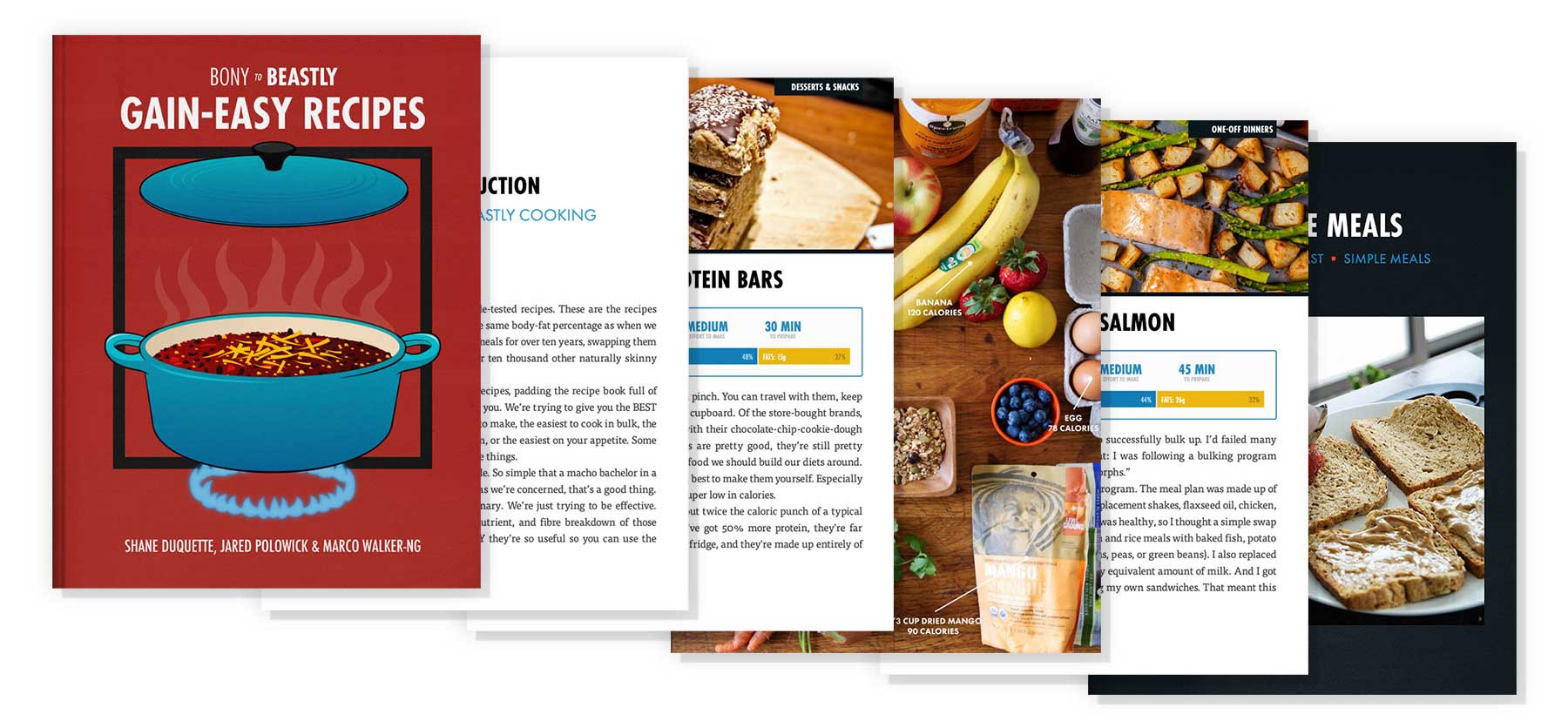
What we do in our bulking program is give guys a full book of recipes, including these ones. All the calories and macros calculated out for you. That way, you can pick and choose, combining them however you like. We have tons of snack options, as well as ideas for how to add calories to all the meals.
You can also keep eating the meals that are already working for you. You don’t have to change everything about your diet. To start, you could swap out your worst meal for your favourite bulking recipe.
You don’t need to cook all your own meals, either. Some fast-food restaurants are quite good. Chipotle is my favourite example. They let you combine a bunch of nutritious bulking foods into a high-calorie burrito.
Adjusting Calories to Guarantee Weight Gain (Crucial)
Calorie calculators aren’t perfect, and there’s a fair bit of genetic variation between people anyway. You can’t just blindly follow a calorie target. You need to weigh yourself every week, see how much weight you’re gaining (or failing to gain), and then adjust your calories accordingly.
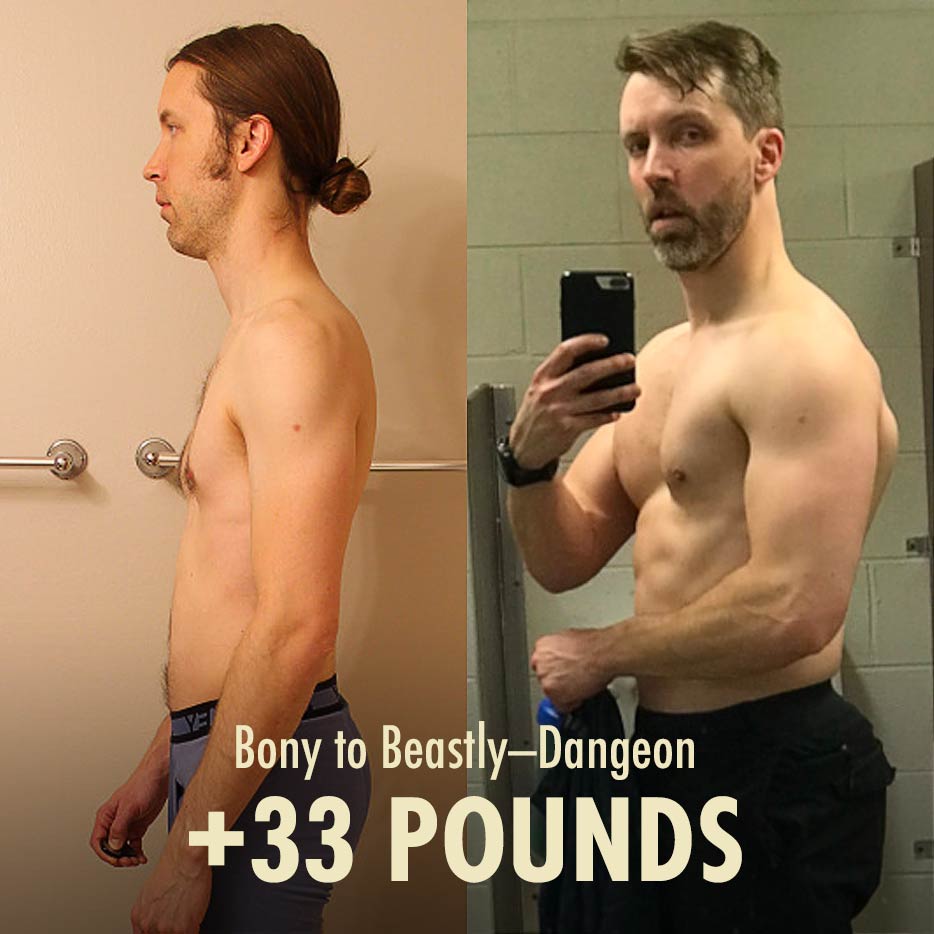
If you aren’t gaining weight, add another 100–200 calories to your diet. You don’t have to track your calories if you don’t want to. You just need to weigh yourself and adjust. Adjusting can be as simple as adding an extra peach to your oatmeal, having a glass of milk with a meal, or dividing your chili into 6 servings instead of 7.
Tracking Calories for Greater Precision (Optional)
You don’t need to track your calories, but it can certainly help. You’ll learn more about the foods you eat, you’ll get into a steadier calorie surplus, and it can be pretty fun, especially if you’re eager to bulk up. It’s especially important if you’re trying to do a lean bulk, which requires eating in a small but consistent calorie surplus.
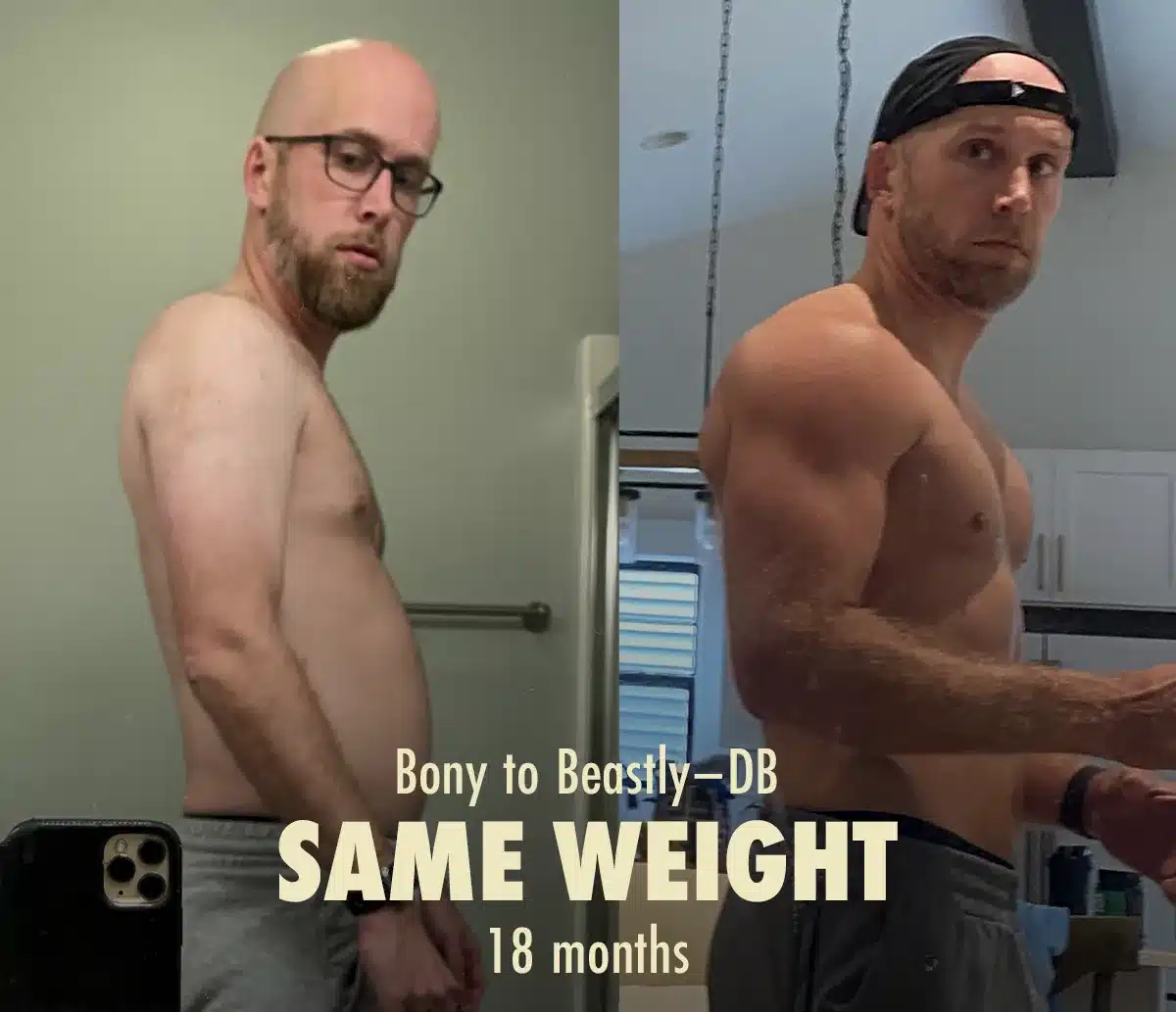
If you want to track your calories, I recommend choosing an app that adjusts your calorie targets based on your weekly weigh-ins. Strangely, most calorie-tracking apps don’t do that, but MacroFactor will. Most calorie-tracking apps are perfectly fine, but I think MacroFactor is the best. Here’s our full review. You can get an extended free trial with our affiliate code, “b2b”.
3 More Free Bulking Recipes
get our bulking recipes—smoothies, snack, & protein balls
4 free bulking recipes
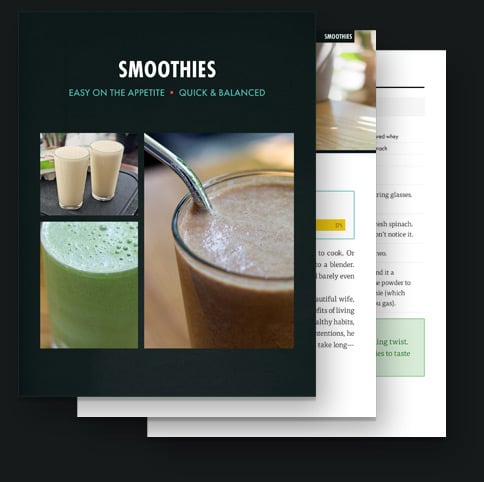
Get four bulking recipes in a downloadable PDF file. Get the full explanation, ingredient list, macros, and steps to follow.
Plus, we’ll make sure you’re on the b2B newsletter, and send you all of our best muscle-building content.
Conclusion
Calories drive weight gain, protein builds muscle, carbs improve performance and growth, healthy fats support powerful hormones, and fibre builds a robust digestive system. A balanced meal has all of them. A balanced diet is made of balanced meals.
Any balanced diet can be great for bulking. These are some of my favourite meals, but you shouldn’t feel like you need to switch your entire diet overnight. In fact, you probably shouldn’t. Your digestive system will probably prefer a more gradual change. Look at your current diet, see which meals need the most work, and swap one or two of them out for better bulking meals.
The other major factors to look into are your workout program (the most important factor), avoiding the vices you already know are holding you back, and getting enough good sleep most nights.
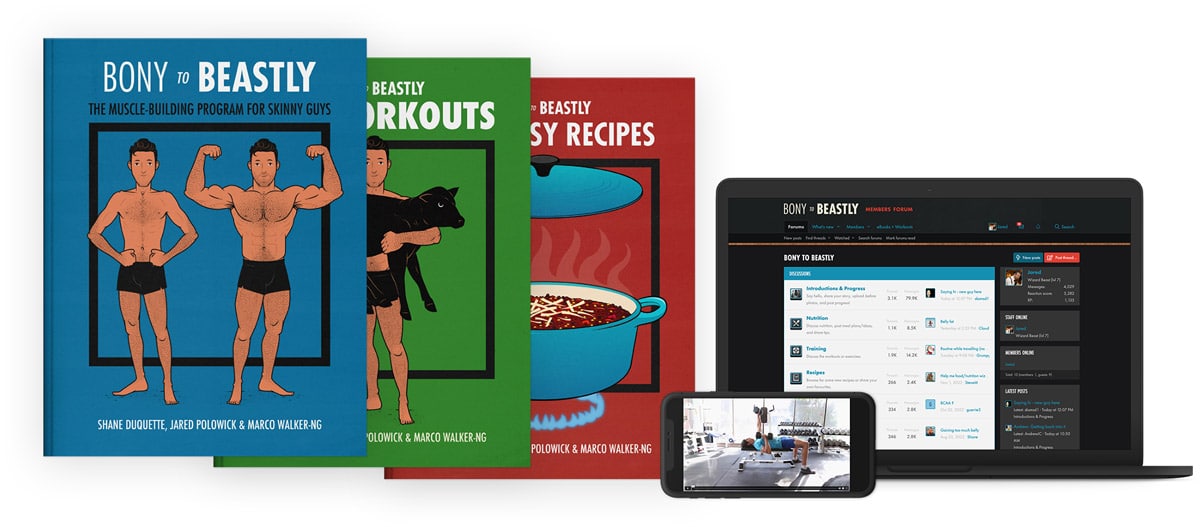
If you want us to walk you through the entire bulking process, check out our Bony to Beastly (men’s) program or Bony to Bombshell (women’s) program. They include a 5-month customizable workout routine, a full bulking diet plan, a bulking recipe book, a deep dive into lifestyle and fitness, and personal coaching from us in our online community.


Muscle-Building Mini-Course via Email
Sign up for our 5-part muscle-building mini-course that covers everything you need to know about:
Here are some related articles